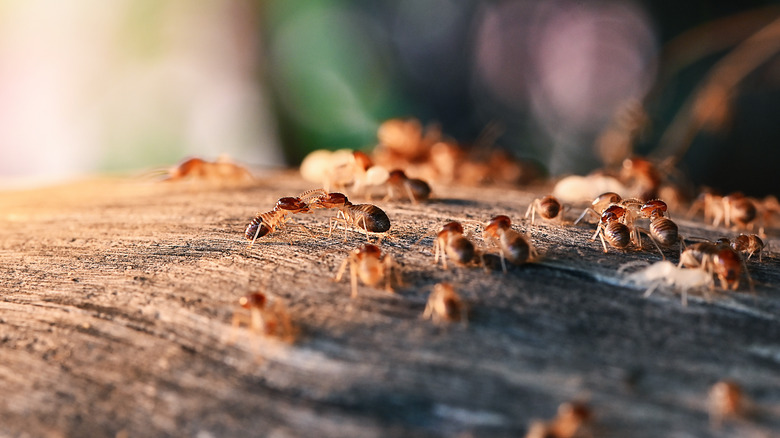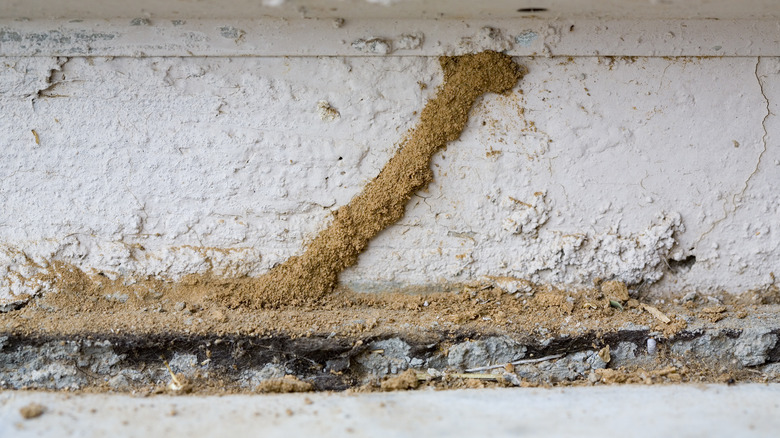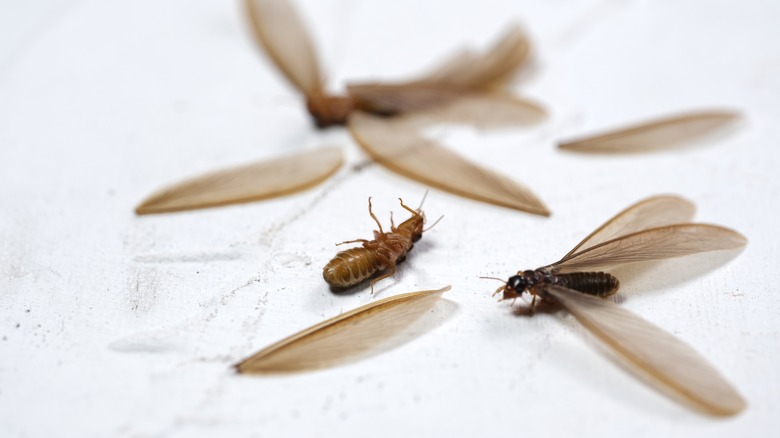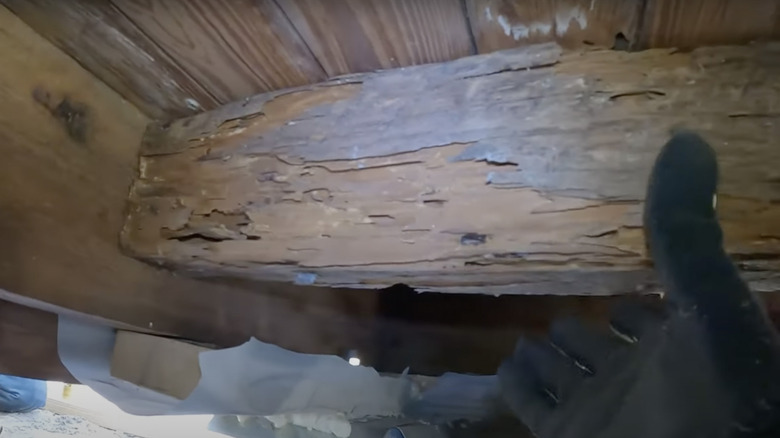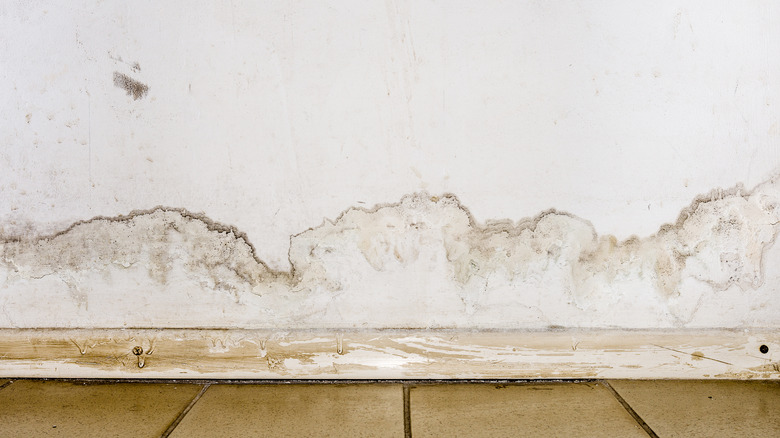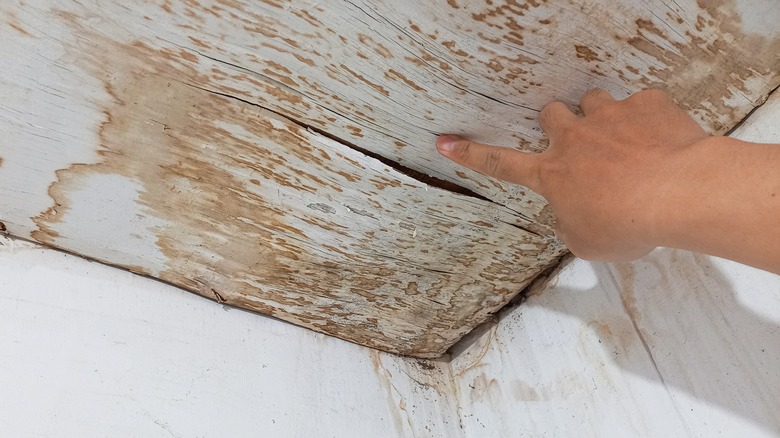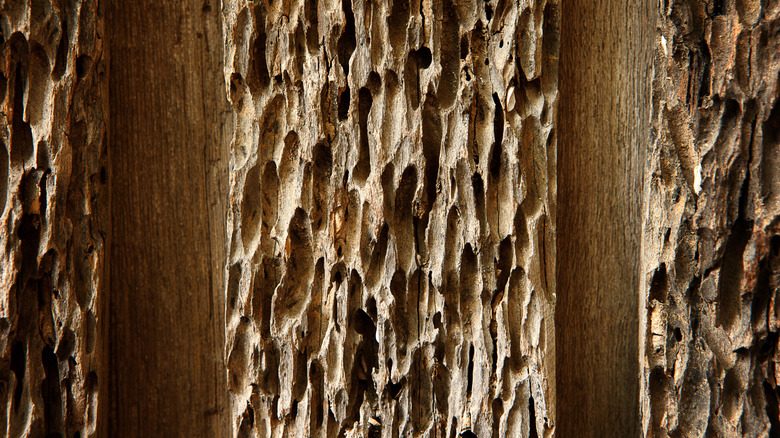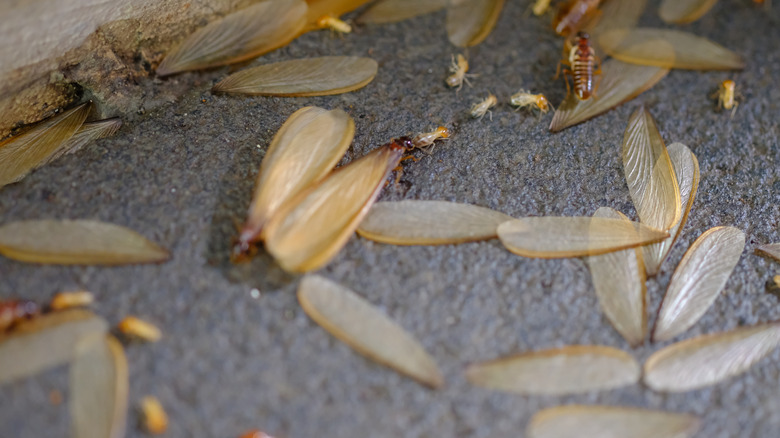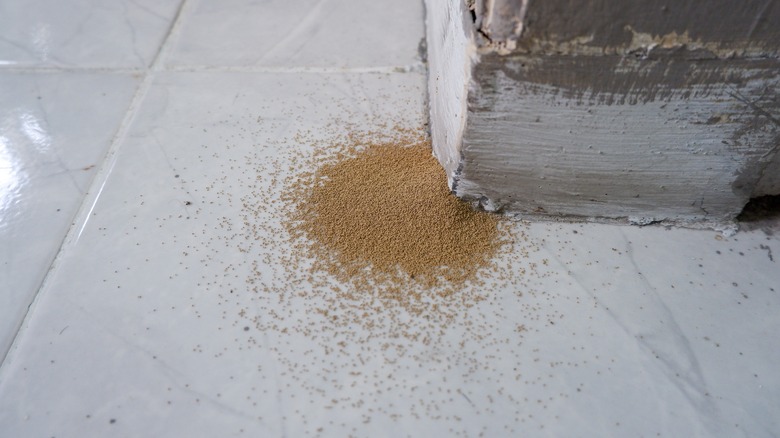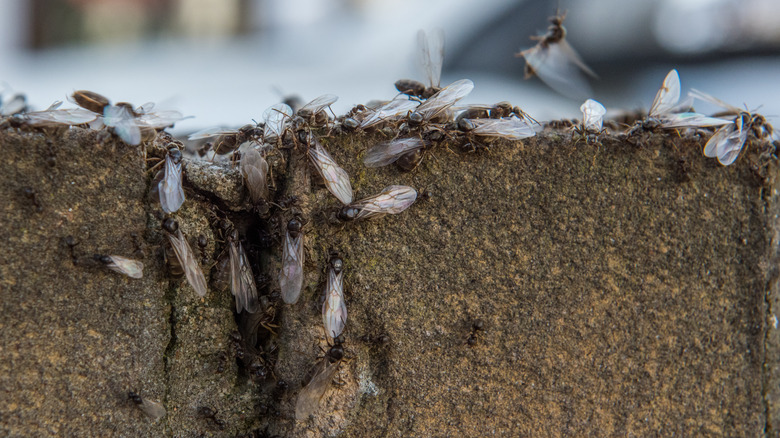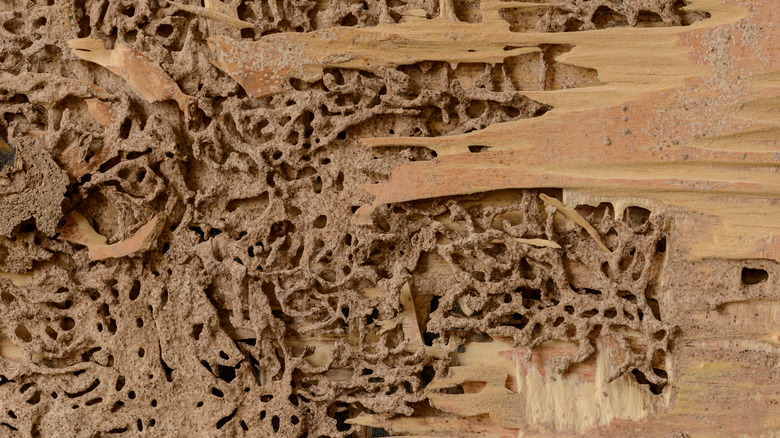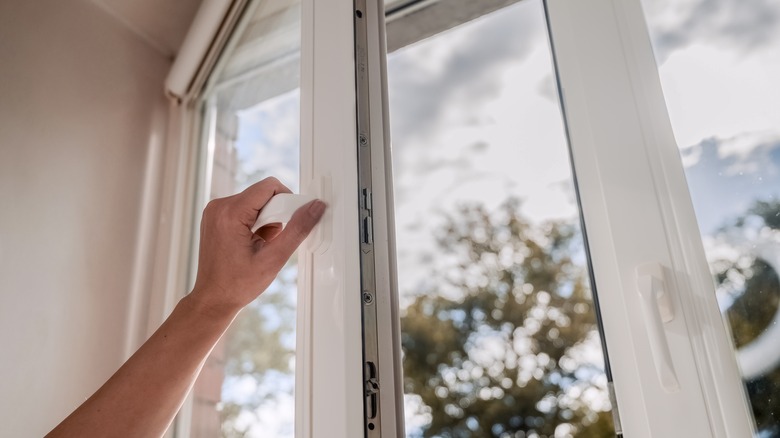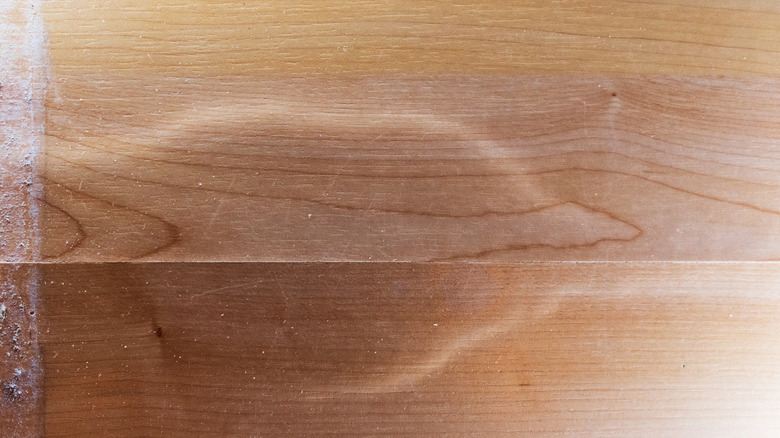12 Surefire Signs You Have A Termite Infestation
We may receive a commission on purchases made from links.
Termite infestations can be destructive and costly if left untreated. To come out ahead, it is essential to be vigilant and identify the signs of termite presence in your home early. The most obvious sign of a termite infestation to look out for is a swarm. During a swarm, you will see thousands of insects all over your home, covering every surface in some rooms. In these instances, you need to call an exterminator right away. Yet sometimes, the signs that these pests have moved in can be more subtle. You might not know you have termites until they have gnawed through so much wood that you are looking at thousands of dollars in damage.
The subtle signs to look out for are things like bowing floors and drooping ceilings. You might notice the paint on your walls suddenly starts peeling or the doors to certain rooms begin to stick when you open them. On their own, these signs might not always mean termites, but when you add them together, they nearly always do. If you know what to look for, you can catch the pests early and get rid of them before they ruin all the wood in your home.
1. You spot mud tubes in or around the house
Termite mud tubes, also known as shelter tubes or mud tunnels, are hard to miss. Termites use them to keep themselves safe and on track when looking for food. The tubes are narrow and completely enclosed. Termites make them by mixing soil, salvia, and body waste. These mud tubes can extend over multiple surfaces, including walls, house foundations, and other any obstacles in the termites' way. They serve as a transportation network connecting the termite colony in the soil to their food source. Seeing these tubes outside your home, near your deck, or even in trees nearby is a surefire sign of a termite infestation.
You might feel like destroying the tubes as soon as you see them. However, it is important not to as you might make the problem worse. If you crack open the tubes, termites will likely start spilling out of them. This won't kill all of the termites — they will simply begin to rebuild. Instead, when you see mud tubes, call an exterminator right away. They will be able to kill the entire colony for you. They will also want to check out the mud tunnels to see what kind of termites live inside and assess the level of risk to your home.
2. You see wings around your home
Termites lose their wings when they are ready to breed. The winged termites, also called alates or swarmers, come out of their nest in a big group to find a new home. They fly for a little while and then land and get rid of their wings. By shedding their wings, they can easily dig into the ground or other good spots to start a brand new termite colony. Once underground, they mate, and one female becomes queen, making the base for the new termite colony. You are most likely to find discarded wings on window sills and ledges, or around outdoor lights like porch or patio fixtures. Remember to check out your basement and crawl spaces for them, too. Termites can sneak in from below and leave their wings in those dark and damp areas. Also, keep an eye out for discarded wings near wooden structures like decks, fences, or anything made of wood.
If you find wings in your home, don't panic. The first step is to ensure they are termite wings. Use a pair of tweezers to pick them up so you don't break them. Look closely to make note of their features. Termites have four equal-sized wings, whereas ants have wings (yes, some have wings) of different sizes: two larger wings in front, and two smaller wings in the back. If you see four wings of the same size, call an exterminator before things spiral out of control.
3. Your floors start to sag or buckle
Termites can cause floors to sag by devouring the structural wood within a building. When termites infest wooden beams, joists, or floor supports, they hollow out the interior, weakening the wood's load-bearing capacity. As a result, the affected structural elements lose their strength and start to sag under the weight they are supposed to support. Over time, this can lead to uneven or visibly sagging floors, causing not only structural issues, but safety concerns, too.
If you know you have termites, sagging floors are a dead giveaway. However, on their own, you might need to do a little bit more investigating. Other factors like water damage, rot, and structural issues can also be responsible. If you can't see any other evidence around the home, like mud tubes or wings, consider calling in a professional contractor or structural engineer. They can assess the problem and let you know if the wood was poorly built, is rotting, or was eaten by termites. In older homes, the damage might even be from termites that have long since moved on. From there, you can determine if you need an exterminator or just need to begin making repairs.
4. Paint in multiple rooms starts to crack or bubble
If there are mud tubes inside your walls, you might notice that the paint will begin to bubble. As thousands of insects move through their tunnels, the structures can trap and accumulate moisture. This is especially true if the termites are feeding on wooden elements in contact with the wall. The trapped moisture can then seep through the wall, affecting the paint. In some cases, as termites hollow out wooden structures like plywood walls, they compromise their integrity, leading to structural instability within the wall. This can cause the underlying surfaces to shift and crack, which can then manifest as cracks in the paint or drywall on the exterior, too.
If you live in an older home, cracked walls or bubbling paint might not always be from termite damage. The issue is only a major cause for concern when it happens suddenly. Termites work quickly, so if your perfect paint job begins to bubble or a crack appears out of nowhere on your wooden wall, it's time to jump into action. You might peel away the bubbled paint to check for damage underneath or tap the wall to listen for hollow sounds. From there, you can call a pest control specialist to finish the job.
5. You notice your ceiling seems to droop
When termites infest the support beams in your home's structure, they consume the wood, hollowing out the beams. This significantly weakens their load-bearing capacity. Over time, this structural weakening can lead to sagging ceilings, as the compromised supports can no longer bear the weight they were designed for.
When examining drooping ceilings for termite damage, it is important to consider context clues. Much like sagging floors, this problem doesn't always indicate a termite infestation — although it is a common problem. Structural issues, poor building practices, and even water damage can also cause ceilings to sag. To determine the cause and assess whether it can be fixed, check for secondary signs of infestation, like mud tubes, wings, and termite droppings. If the issue is termite-related, it's essential to address the termite infestation first, as termites can continue to damage the structure. Once the termites are eliminated, the structural damage can be repaired.
6. Your backyard is full of rotting wood
If you have lots of rotting trees in your backyard, it might be because of termites. Take a look at each damaged tree's bark. Termites create concealed pathways beneath the tree's bark as they tunnel through the wood. Look for irregular patterns of damage, like cracks or splits on the tree's surface, as these can be indicative of termite galleries. You should also check for sections of bark that appear loose or detached, as termites may ruin it in their pursuit of cellulose-rich wood. If you notice these things early, you might have a shot at stopping the spread into your home.
Even if there aren't any signs of termites, if there are dead trees or decaying wood in your backyard, you should get rid of it ASAP. Termites can use these trees or woodpiles as a starting point before progressing to healthier trees or, ultimately, your house. Regular tree maintenance, including tree removal when necessary, can disrupt their access route and reduce the risk of infestation spread. You can also opt for termite-resistant plant species in your landscaping as a protective measure. While no plant is entirely immune to termites, some are less attractive to them. Old wives' tales say that marigolds and lemongrass are known to be less appealing to the bugs, making it harder for them to establish colonies near your house.
7. You experience a swarm of termites
When termites are looking for a mate and ready to establish a new colony, they swarm. This usually happens in warmer temperatures and climates with lots of humidity. During swarming, certain termites leave their original colony. The primary objective of these parties is to maximize the production of offspring and strengthen the genetic diversity of the new colony. When termites swarm, they take over everything. You might open the door to your bedroom and see it covered top to toe in bugs. When this happens, it's pretty obvious you have an issue.
The good news is that if you see a termite swarm outside your house, it doesn't necessarily mean that your home is infested. They might just be in the stage of looking for a new place to set up shop without having done it yet. However, it's crucial to treat a termite swarm as a warning sign and take action promptly. Call an exterminator, tell them there has been a swarm, and book the next available appointment.
8. You find termite droppings around the house
Termite droppings, often referred to as "frass" by those in the business, are small, pellet-like excrement left behind by termites. These droppings are typically a combination of digested wood fibers and feces. They can vary in appearance depending on the species of termite, but they often resemble tiny, elongated granules or capsules. Termite frass is typically a uniform color, like beige or brown, and may be mistaken for sawdust or sand due to its small size.
This frass is then expelled from the termite colony through small openings, known as kick-out holes, in the infested wood. These holes are often a telltale sign of termite presence, as the termites push the frass out to keep their galleries clean and maintain a nice environment for their colony. Detecting termite droppings is a critical sign of a termite infestation. If you see sawdust in your home, but haven't recently done any sanding or sawing, know that it is not really sawdust. Instead, recognize it as a sign of termites. Take immediate action to protect your property from damage by calling a pest control specialist.
9. You think you have a flying ant infestation
Flying ants look a lot like termites. It can be easy to mix up the two. These ants are reproductive individuals within an ant colony. Their primary role is to participate in the mating flight, where male and female ants from different colonies meet in mid-air. Flying ants often emerge in the spring or summer. After mating, the males die, while the fertilized females land to establish new colonies. These females shed their wings, and the process marks the beginning of a new ant colony. This ritual looks a lot like a termite swarm, and a termite swarm looks a lot like this ritual, so sometimes it can be confusing to know what's really going on.
However, several key characteristics help you to tell them apart. Flying ants have bent or elbowed antennae, and their bodies have a noticeable constriction or waist between the thorax and abdomen. In contrast, termites have straight, beaded antennae, and their bodies lack a distinct waist, appearing more uniform and straight-sided. Another distinction lies in their wings. Flying ants have forewings that are larger than their hindwings, and these two pairs differ in size and shape. Termites, on the other hand, have two pairs of wings that are the same size and shape. If you can't tell, call an exterminator because you will want to get rid of them either way.
10. You see tunneled-out wood around your home
Sometimes termites might not be in the walls — they might show up in your deck or wooden furniture. If you suspect termites on your deck, the best way to check is with a spring in your step. If you skip around your deck, you will be able to feel how the wood responds to you. If it gives at all, there is damage to it, as healthy wood should feel sturdy. Things also might be more obvious. There could be tunnels or visible damage on the outside of the deck, too. The same goes for furniture. If small holes appear in the exposed parts of your wooden furniture, you have a problem.
The first step is to remove the infected furniture from your home. You don't want to give the insects a chance to spread. In case they already have, or you find evidence of terminates on your deck, call an exterminator. In the meantime, you can spray termite-killing chemicals around the exterior of your home and your deck. While you can't completely DIY a termite killing, you can typically kill enough of them to keep you in the clear until reinforcements arrive.
11. Your doors and windows are hard to open
If you notice that your doors and windows are suddenly hard to open, it could be termites. Sometimes, when you live in a very humid environment, wood warps in the weather. The moisture, or lack thereof, can cause it to expand and contract. Yet, termites also have the same effect. When they eat through the wood, it creates moisture, causing the same warping. If the weather is dry and you notice this phenomenon, it could easily be from termites.
Before you call for pest control, do a few tests to make sure it is insects and not just humid weather. Press around the edges of the door or window. Do they seem brittle to you? If you knock on the wood, does it sound hollow? As termites eat through the wood, it hollows out, which is typically easy to hear. Can you see any other signs of termites around, such as droppings or mud tunnels? If you answered yes to any of these questions, call for backup. If not, it might just be warping due to weather, but it's still best to keep an eye on things.
12. You might spot small blisters on your floor
When termites are eating away at the wood under your flooring, the moisture they create causes small blisters to appear. These little bubbles can sometimes look a bit like water damage. However, if you know no pipes run under this spot, and there is no leak from the ceiling or spills in sight, it is likely termites.
To tell the difference for certain, take a closer look at the way the wood appears to be damaged. If the damage is from water, the wood will usually be different colors and smell bad, like must or mildew. If there are small blister bubbles or any sort of tunnel — it's termites. If you press your fingers down on the bubbles and they feel hollow underneath or they crumble to reveal powder that looks like sawdust — it's termites. Wood that is rotting is uneven and breakable; termite-damaged wood is tunneled and hollow.
